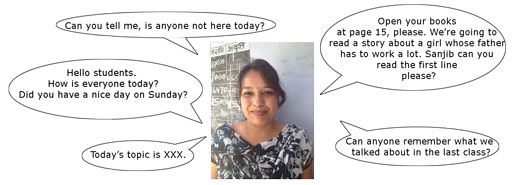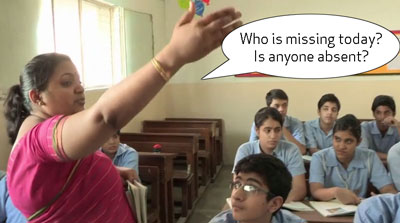1 English for everyday classroom activities
Everyday classroom activities can provide meaningful authentic opportunities for your students to regularly listen to and speak English. Such small activities can include things like greeting your students, taking attendance, introducing a new topic or giving instructions. Using English like this in the classroom is beneficial for your students because they get to hear more English and they hear how the language is used in real-life communication. It also gives them a purpose for speaking English.
Pause for thought Think about the last English class that you taught:
|
In order to be able to communicate using English, students need to be able to hear and speak the language regularly in lots of different settings and with lots of different tasks, not just in textbook exercises.
Activity 1: Increasing your use of English
Part 1: Thinking about your practice
Think about the classroom situations listed below. What do you usually say to your students in these situations? Which language do you usually use? Are there some activities for which you always use students’ home language and others for which you use English? Could you increase your use of English? Discuss these questions with a colleague if you can.
- greeting students
- taking attendance
- giving instructions
- checking previous knowledge
- managing behaviour
- encouraging students to speak
- praising your students
- giving homework
- saying goodbye
- talking to your students about their lives .
Table 1 lists some everyday classroom routines. There are some English phrases that you can use for each situation. Write some more phrases in each box.
| Classroom situation | English phrases |
|---|---|
| Greeting students | Namaste. Good morning. How are you today? |
| Taking attendance | Who is missing today? Is anyone absent? |
| Giving instructions | Students, please open your book at page 15. Now we will do lesson 10. |
| Checking previous knowledge | The topic of the lesson is Nelson Mandela. Can anyone tell me who he is? |
| Managing behaviour | Students, could you all sit down please. |
| Encouraging your students to speak | Would you like to try to answer, Sandesh? |
| Praising your students | Very good! |
| Giving homework | Please finish this activity at home. |
| Saying goodbye | OK, that’s all for today. Goodbye. See you all tomorrow. |
| Talking to your students socially | What did you do yesterday after school? |
When you have added some phrases to the list, compare yours with those listed in Resource 1.
Part 2: Preparing to teach
Now choose some English phrases from the phrases that you wrote in the table that you have not tried in your classroom before, or choose some from Resource 1. Practise these sentences aloud, at home or with a colleague.
Remember that your students may not understand the phrases at first. Gestures and actions will help them to follow. For example, you could use this gesture when you say:
Practise the gestures as you say the phrases.
Part 3: In the classroom
When you feel confident with a new phrase, try it out in the classroom. Use gestures and encourage students to respond in English or in their home language.
Whenever you use new phrases in the classroom:
- Don’t worry too much about making grammatical mistakes. Your students probably won’t notice.
- Don’t worry too much about your pronunciation. It is just important for students to listen to English being spoken. You can practise the pronunciation of certain words and sounds before your lessons if you are concerned. Or practise with a friend or colleague (see Resource 1).
- If your students don’t understand something at first, don’t translate it. Repeat the phrase a few times and give your students some time to work out what you are saying. Try using gesture and actions to show what you mean.
- Remember that your classes don’t need to be entirely in English. It is good to use students’ other languages to check their understanding. Just try to use more and more English over time.
You can start using English any time. Any amount of English is better than none. If you feel like it is difficult for you, or that your students don’t respond, keep trying. Don’t give up!
Case Study 1: Mr Jhadav uses more English in his English class
Mr Jhadav has been teaching English to secondary students for a number of years but his students are not confident enough to speak it themselves. He decides to speak more English in the classroom to help them learn the language. Although he finds it difficult at first, he notices that his students soon get used to hearing more English in class.
I was thinking about my last class and how much English I use. I tend to mostly just read out the lesson. I’d like to use more spoken English in the classroom. I used to use quite a lot of English when I was studying to become a teacher, but now I am out of practice. So before starting to use more English with my students, I decided to practise on my own. I tried to think of the things that I usually say to students in students’ home language, like ‘Today we are doing Lesson 3’, and ‘Can you read the next line please?’ I practised these phrases over and over to myself in English and out loud, so that they would sound natural when I used them with the students.
The next day I started my class by saying:
They looked at me with some surprise. At first, no one responded. So I repeated the instruction to open their books two more times. Eventually, they all had their books open on the correct page. Then I got my own book and I showed them the picture on page 3. I repeated the question:
It was quiet, but I waited a few moments for my students to reply. Eventually one student said ‘tired’. So I replied: ‘Good! Yes, I think he’s tired.’
From this day, I started using more and more English with my students in class. I began to give classroom instructions like ‘Can you read the next line please?’ I was surprised at how quickly they got used to my speaking to them in English. Sometimes I had to repeat the instructions a number of times, but soon most of them understood.
I am slowly starting to use more and more English in the classroom, and I am getting more confident about it. I am sure I make some mistakes and my pronunciation isn’t perfect, but my students don’t seem to notice. Sometimes I have problems with vocabulary, and I can’t think of a word or phrase I want to use in English. When that happens, I try to think of another way to say what I want in English. As a last resort, I use the Hindi word. I try to make a note of the words I don’t know. After class, I ask a colleague or look the word up in the dictionary. This is helping me to improve my English too! And I notice that my students are beginning to become more confident with speaking a few words of English when they reply to me. I try not to correct them immediately but listen to the sense of what they are saying.
What you can learn in this unit





